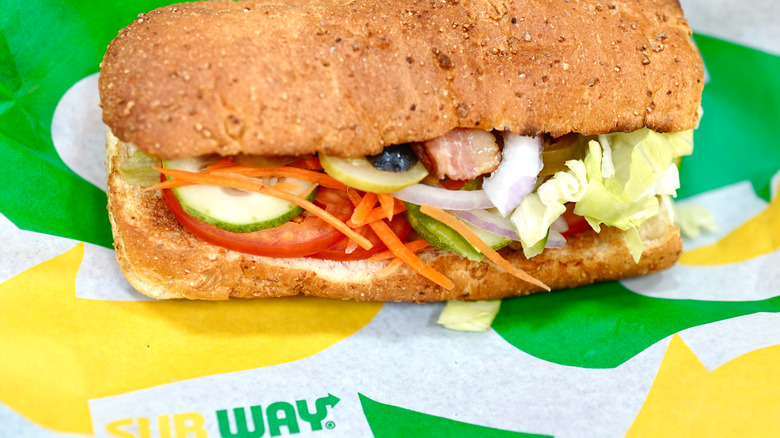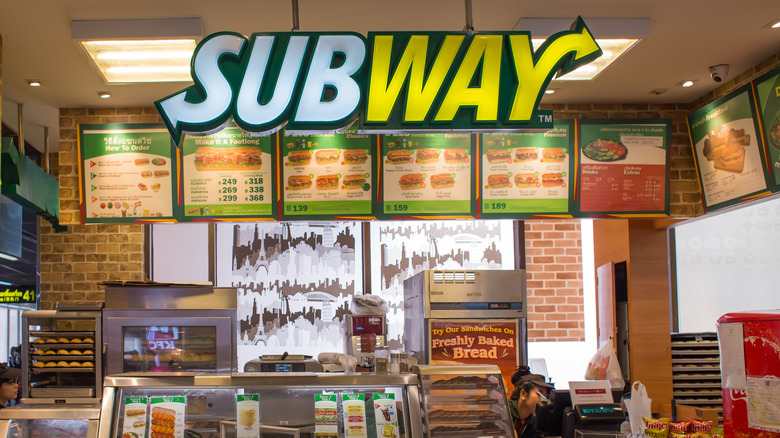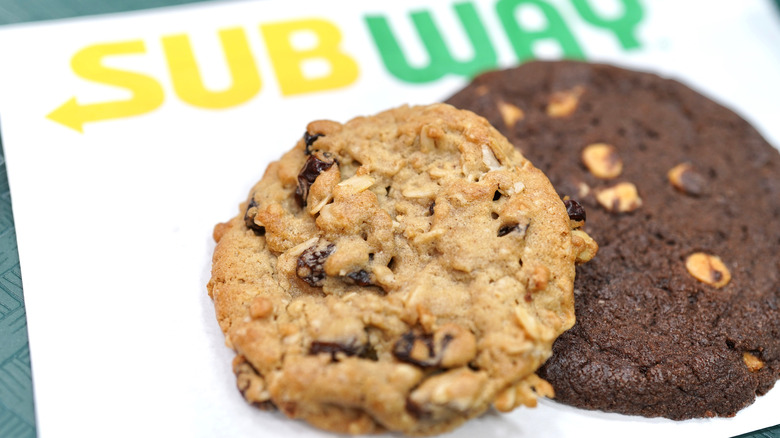What Subway Was First Called
Every restaurant has an origin story, but only one involves a nuclear physicist and a 17-year-old kid: Subway. The popular sandwich eatery earned the Number 3 spot in QSR's list of Top 50 Fast-Food Chains in America. It also ranked eighth in a Healthline list of fast-food restaurants that serve healthy foods, but just like any other flourishing business, Subway's success didn't happen overnight. Certain changes had to happen first, including to the name of the restaurant.
In 1965, a boy named Fred DeLuca had a financial dilemma that millions of other teens his age face every year. At 17, he wanted to attend college to become a doctor but couldn't afford it on his own. So, DeLuca reached out to a family friend Dr. Peter Buck for help (via Subway). That friend happened to be a successful nuclear physicist involved in designing nuclear power plants at the time, according to The New York Times.
Buck recommended that DeLuca open up a sandwich shop to earn money for college. The newspaper also reported that Buck drove him from Connecticut to Maine to visit a specific sandwich shop for inspiration. Confident that DeLuca would succeed, Buck loaned DeLuca $1,000 and partnered with him on his mission to open his own restaurant (via Subway).
Just two weeks later, their plan came to fruition when they opened a submarine shop in Bridgeport, Connecticut. But the duo changed the name three years later in an effort to improve their marketing.
The original restaurant name was not a success
As the sole investor of the restaurant, Dr. Peter Buck named the sandwich shop after himself, calling it Pete's Super Submarines. It sold 312 sandwiches on its first day, according to ctpost, but sadly, the restaurant didn't do very well overall during its early years. One of the reasons involves a specific radio advertisement.
Fred DeLuca, who was born in New York, recorded the ad himself, but there was one problem. When he said, "Pete's Submarines," listeners thought he was saying "Pizza Marines" (per The New York Times) because of his heavy New York accent, and they were left confused. It's unclear why DeLuca didn't just say the full restaurant name after that to resolve the issue. Instead, the founders changed the name to Subway in 1968, according to Subway.
Another uncertainty involves a photo that appears on the restaurant's history page. The photo shows "Pete's Subway" as the name of the restaurant, but the site gives no explanation for this particular name. We know from this image that the name changed from Pete's Super Submarines to Pete's Subway to Subway, but the "Pete's Subway" chapter of the story appears to be missing from the site.
Subway, from 1968 to today
With the new Subway name, Fred DeLuca and Dr. Peter Buck continued to branch out with new locations in the United States and other countries. Today, you can enjoy a 6-inch or footlong submarine sandwich with the toppings of your choice on any continent (except Antarctica, of course), according to Subway. The restaurant prides itself on being the largest worldwide restaurant chain.
Subway's menu items also multiplied and improved over time. In 1975, the brand introduced the classic BMT, which is now its "flagship sandwich" (via Subway). The 6-inch sub was also introduced in the '70s, which were originally called Snaks. You can also now order wraps, salad bowls, breakfast, and melts, with cookies or chips — or both — on the side.
With the restaurant's success, you may be wondering if DeLuca ever achieved his dream of becoming a doctor, the dream that gave birth to the Subway franchise. While he did attend college as he set out to do, he changed his mind about medical school. The New York Times reported that he instead earned a degree in psychology from the University of Bridgeport in 1971.
Neither DeLuca nor Buck could have predicted that a $1,000 loan could have led to one of the most successful fast-food chains in the world. They both took a chance, and although no one will ever confuse the name with "Pizza Marines" again, Pete's name will always be an important part of Subway's history.


